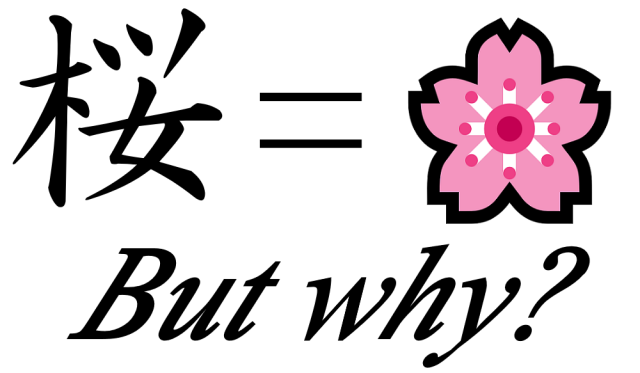
There’s a beautiful reason why the kanji for cherry blossoms looks the way it does, and remembering it makes the character a snap to write.
With cherry blossom season in full swing here in the Tokyo area, it’s a great time to look at sakura, so let’s do that right now…and by that I mean let’s look at the Japanese kanji character for sakura.
Beautiful, isn’t it? Unfortunately, the same artistic qualities that make kanji so beautiful to look at can also make them a huge pain in the butt to write, since you can’t exactly remember how to “spell” a picture. However, you can make things a lot easier by breaking each kanji down into its component parts, and if you know why those parts were chosen to represent that word, the whole thing becomes easier still.
So let’s take a look at what goes into the sakura kanji, and luckily everything is there for a pretty logical reason. To start with, we’ll shift from the brush stroke-style seen above to block printing, which should make things a little easier to see.
We’ve got three sections to look at, so let’s circle those right away.
When writing the sakura kanji, the part circled in blue comes first, so that’s where we’ll start answering the question of “Why?”
This part, with a tall trunk standing in the middle and branches coming off of it, represents a tree. That makes sense, right? After all, sakura is both the word for cherry blossoms and the non-fruit-bearing cherry trees the flowers grow on.
This first section of the sakura kanji has four strokes, and the order you write them in (as well as the direction your pen/brush should move) are shown below.
Next, let’s hop on over to the top-right section.
The Japanese language throws us a bone here. Long ago, this section was a lot more complicated than these three little lines, and the sakura kanji looked like this:
By itself, 貝 is the kanji for shell, but two of them together like this signifies a necklace, as shiny shells were some of humanities earliest accessories, back in the days before mining and polishing gemstones were beyond craftsmen’s capabilities. Eventually, though, even Japan thought the old-school sakura kanji was taking too long to write, and so they simplified the upper right section into what we see in the standard sakura kanji used today, proving that “Dude, come on, you know what I’m trying to say, right?” is something that even our cultured ancestors sometimes thought (although the more complex sakura kanji does still show up today in some family names).
▼ While it’s not the real reason they’re there, it’s also a handy mnemonic device to think of the three lines as a trio of cherry blossom petals fluttering gently in a spring breeze.
And finally, let’s head down to the bottom-right portion and finish the sakura kanji off.
By itself, 女 is the kanji for “woman,” which originated as a drawing of a woman with her hands folded while elegantly kneeling Japanese-style. It’s a bit of an abstract rendering, but it’s still pretty easy to see 女 as a picture of a person with easily identifiable arms, legs, torso, and neck.
▼ The first stroke for this section is just a little tricky, as the down-and-to-the-left motion shifts to down and to the right without lifting the tip of your pen/brush.
So in the end, the kanji for sakura looks the way it does because of “tree necklace woman,” or, to put things a bit more eloquently, because the cherry blossom is a plant whose five petals seem to be forming a beautiful necklace around the center of the flower.
Now that we know why the kanji for sakura is written the way it is, it should be a lot less intimidating to write, and though, at 10 strokes, it’s not the quickest kanji to write, even writing “sakura” in English will take you at least seven pen strokes, and possibly more, depending on how you write each letter.
Oh, and if you find it easier to remember the upper right portion as falling flower petals than a super-simplified necklace, making the picture the kanji paints one of a woman relaxing under a cherry blossom tree and perhaps enjoying a hanami party, that’s fine too. Ultimately how you remember the kanji for sakura is up to you, just like how you choose to enjoy the blossoms themselves.
Reference: Ichigo Ichina, Okijiten
Sakura photo: Pakutaso
All other images: SoraNews24
● Want to hear about SoraNews24’s latest articles as soon as they’re published? Follow us on Facebook and Twitter!
Follow Casey on Twitter, where he’s in a long-term love/hate relationship with kanji.